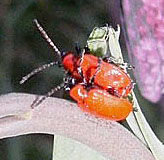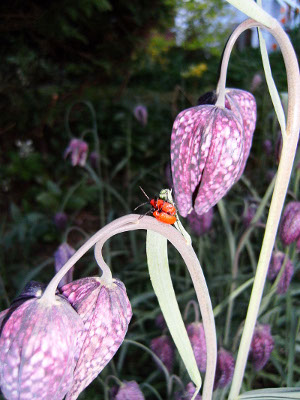Worcestershire Record No. 28. April 2010

|
Lilioceris lilii
(Chrysomelidae)
©Keith Barnett
|
|
LILY LEAF BEETLE Lilioceris lilii IN GREAT MALVERN
Keith Barnett
The Lily Leaf Beetle is a native member of the Coleoptera of Europe and Asia that is readily recognisable by its bright scarlet body and black legs, head, antennae and undersides. Although visually attractive as adults, the larvae are hardly so, having swollen slug-like bodies, orange, brown, yellowish or greenish, coupled with the somewhat unappealing characteristic of secreting and carrying their excrement on their backs.
The insect has spread widely from its countries of origin, and in all its forms now presents a pest to horticulturists and gardeners. The adults will feed only lightly on a range of genera including Lilium, Fritillaria, Polygonatum and Solanum (especially Bittersweet and Potato). This activity merely disfigures the plants, but much worse and often fatal damage is caused by the larvae. These hatch from reddish-orange eggs laid in the spring (up to 450 at a time) on the underside of the leaves of Lilium and Fritillaria, which then provide food for a period of 16-24 days. After this, the larvae enter the soil to pupate - the pupae are fluorescent orange in colour - emerging as adult beetles in 16-22 days and feeding until the autumn before overwintering in soil or garden debris, often some way from the host plants.
I have never come across this insect before, which I think it may perhaps be quite uncommon in the Malvern area, where I live. However, on 24 April 2010 I found two mating beetles on the stems of Fritillaria meleagris in my garden (grid reference SO796455) (see photograph): I have since seen another three individuals in exactly the same place.
Reference: University of Rhode Island Plant Sciences Department, 2002: URL GreenShare factsheet. http://www.uri.edu/ce/factsheets/sheets/lilyleafbeetle.html
RECORDS OF LILY BEETLES IN WORCESTERSHIRE
Records held by Worcestershire Biological Records Centre extracted by Jenni Schenke 10th May 2010 are shown in the table:
|
Scientific Name
|
Grid Ref
|
Location Name
|
Date
|
|
Lilioceris lilii
|
SO921414
|
Eckington
|
14/08/1996
|
|
Lilioceris lilii
|
SO986473
|
Lower Moor
|
21/10/2002
|
|
Lilioceris lilii
|
SO886624
|
Droitwich
|
18/03/2003
|
|
Lilioceris lilii
|
SO966431
|
Windy Ridge, Little
Comberton
|
30/07/2004
|
|
Lilioceris lilii
|
SO966430
|
Little Comberton
|
08/05/2005
|
|
Lilioceris lilii
|
SO966431
|
Windy Ridge, Little
Comberton
|
08/05/2005
|
|
Lilioceris lilii
|
SO966431
|
Windy Ridge, Little
Comberton
|
11/05/2005
|
|
Lilioceris lilii
|
SO966431
|
Windy Ridge, Little
Comberton
|
25/06/2006
|
|
Lilioceris lilii
|
SO928486
|
Drakes Broughton
|
25/06/2006
|
|
Lilioceris lilii
|
SO922434
|
Defford, The Acre
|
01/07/2006
|
|
Lilioceris lilii
|
SO943365
|
Kemerton
|
09/08/2006
|
|

Lily Leaf Beetle Lilioceris lilii
(Coleoptera: Chrysomelidae)
in Great Malvern
©Keith Barnett
|
The following note appeared in Worcestershire Record No. 17 November 2004 pp. 26-27. Although we have received many records of Harlequin Ladybird records since then the WBRC has received remarkably few records of Lily Beetle. If you have them in your garden please send in the records.
THE LILY BEETLE LILIOCERIS LILII AND THE HARLEQUIN LADYBIRD HARMONIA AXYRIDIS: TWO SPECIES WORTH LOOKING OUT FOR
Harry Green
Worcestershire Record No. 17 November 2004 pp. 26-27
The lily beetle Lilioceris lilii
This species has been spreading throughout Britain and is a serious garden pest in parts of southern England, attacking various garden lilies and fritillaries. There are quite a few records from Worcestershire (VC37) but it is probably under-reported to WBRC. Please look out for the beetle and send in records. They appear in spring and early summer, eating holes in the leaves and weakening the plants.
The beetles are 6-8 mm long, bright red with a black head, legs and underparts. Both they and the reddish grubs attack the plants. The beetles lay clusters of red eggs. Be sure you can distinguish them from other species, such as cardinal beetles, though the latter occur in quite different habitats. If in doubt send specimens to the WBRC office.
A web search will provide readers with plenty of interesting material! A useful start is the Royal Horticultural Society web site www.rhs.org.uk.


